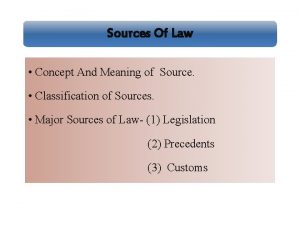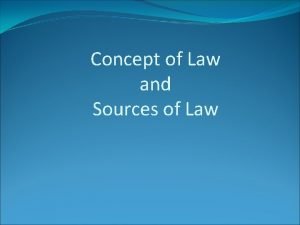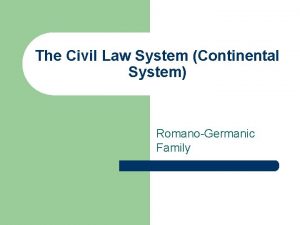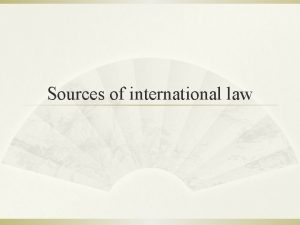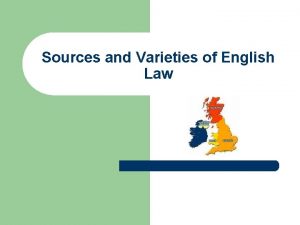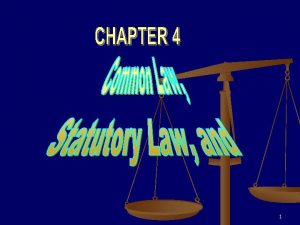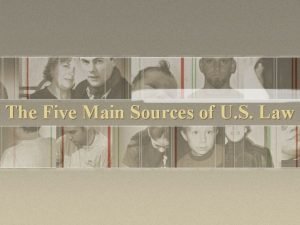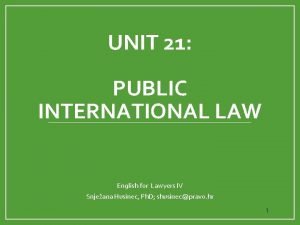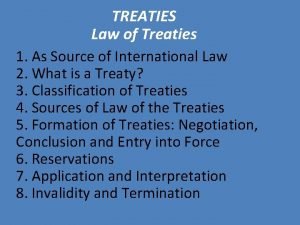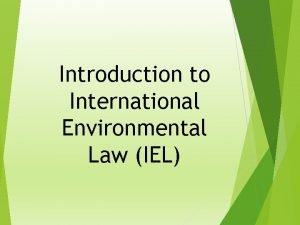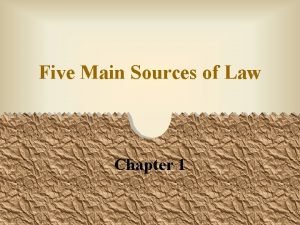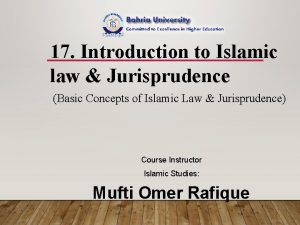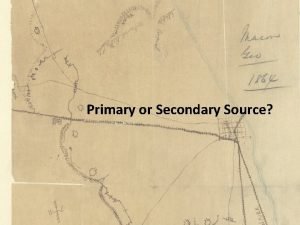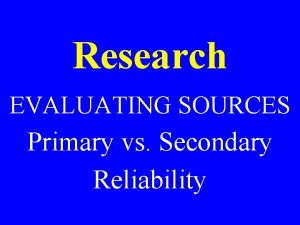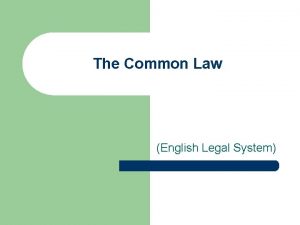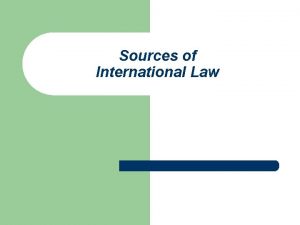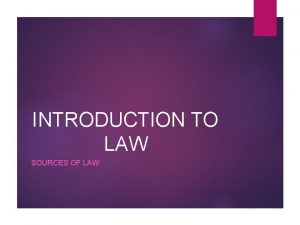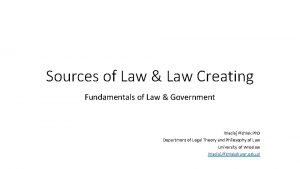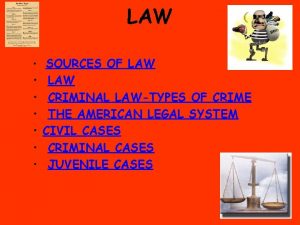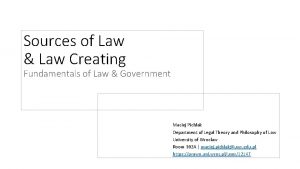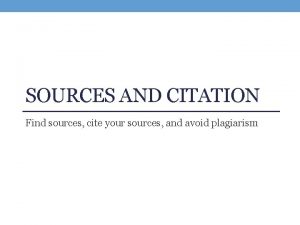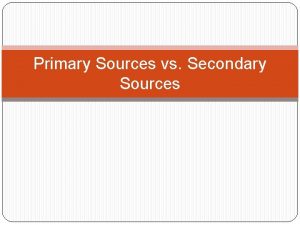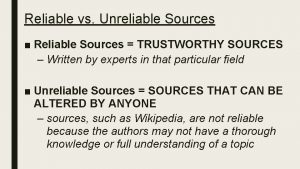Sources Of Law Concept And Meaning of Source

























- Slides: 25

Sources Of Law • Concept And Meaning of Source. • Classification of Sources. • Major Sources of Law- (1) Legislation (2) Precedents (3) Customs

Concept & Meaning • • • The term ‘sources of law’ – Used in different senses by different writers and different views have been expressed from time to time. Holland – The expression ‘sources of law’ is sometimes employed to denote the quarter whence we obtain our knowledge of law. e. g: Whether from the statute book, the reports or esteemed treatise. Sometimes the term is used in the sense of the Sovereign or the State from which law derives its force or validity.

• • • Sometimes used to denote the causes of law or the matter of which law is composed. Sometimes it also indicates the organs through which the State either grants legal recognition to rules previously unauthoritative or itself creates new law, e. g. adjudication, equity & legislation. Also used to point out the origin or the beginning which gave rise to the stream of Law.

VARIOUS VIEWS: • C. K. Allen – uses it in the sense of agencies through which the rule of conduct acquire the character of Law by becoming definite, uniform and compulsory. • Vinogradoff –uses it as the process by which the rule of law may be evolved. • Oppenheim – uses it as the name for a historical fact out of which the rule of law may be evolved.

• • According to School of Natural Law – Law has a divine origin. Every Law is the gift of God & the decision of sages. John Austin who led the Analytical School of Law refers to 3 different meanings of the term ‘ Sources of Law. ’ 1. To the immediate or direct Author of Law, which means the sovereign in the country. 2. To the historical document from which the body of law can be known, e. g. , the Digest Code of Justinian. 3. To the causes which have brought into existence the rules which later on acquire the force of Law. E. g. Customs, judicial decisions

• • The Historical School of Law represented by persons like Savigny, Sir Henry Maine, Puchta, etc. attacked the Analytical School. Their contention was – Law is not made, but is formed. The foundation of law lies in the common consciousness of the people which manifests itself in practices, usages & customs of the people. Again the Sociological School of law protests against this orthodox conception of law, i. e. it emanates from a single authority in the State. According to this school, law is taken from many sources & not from one.

• • Ehrlich writes: At present as well as any other time, the centre of gravity of legal development lies not in legislations, not in juristic science nor judicial decisions, but in society itself. Duguit writes that law is not derived from any single source and the basis of law is public service. There need not be any specific authority in a society which has the power of making laws.

SOURCES OF LAW AND SOURCES OF RIGHTS • Sources of Law may also serve as sources of rights. • By Source of Law is meant some fact which is legally constitutive of rights. • It is the defacto antecedent of a legal right in the same way as source of law is defacto antecedent of a legal principle. • To a large extent , the same class of facts which operates as source of law also operate as sources of right

• Some facts creates rights & not laws, some create laws & not rights and some creates both. e. g: Decision of inferior courts act as source of rights but are not laws. Immemorial customs gives rise to rights and law at the same time.

Classification Of Sources Of Laws: The view of Salmond was that the two main sources of law were- Sources of Laws Material Formal Legal Historical

sources those • Formal as Sources: it. Salmond defined from which a rule of law derives its force and validity. The formal source of law was the will of the state as manifested in statutes or decisions of the courts. The authority of law proceeds from that. • Material Sources: Are those from which the matter is derived, though not validity of the law. The matter of law may be drawn from all kinds of material sources.

• Again Salmond classifies material sources of law as legal & historical sources. •

• Some laws which emanates from legal sources are: (a) Statutory Laws: These are enacted by the legislature & as such legislations are the source of law. (b) Case-Laws: These refer to the decisions delivered by the courts & developed in form of case-laws. They find their main source in the doctrine of precedents. (c) Customary Laws: These are derived from customs, which are practiced as habits over generations. It has its source in customs.

(d) Conventional Laws: These are the laws which are generally derived from conventions/practices contained in contracts & agreements. Here the agreements serve as the source of these laws. • Historical Sources : These are those sources where rules which subsequently turned into legal principles, were first to be found in an unauthoritative form. They are not allowed by the law courts as of right. They operate only mediately and indirectly.

• Its concerned with Legal History & not with Legal Theory. • These sources however can become legal sources if they are so recognized by the state & are included in the law. • Majorly we can classify the following as Historical Sources – 1. Juristic Writings 2. Literary Works 3. Foreign Decisions

• In respect of its material origin, a rule of law has often a long history. Rule of Law Legal Source Decision Of Court of Law Writing of some lawyer, e. g Pothier Historical Source Lawyer himself may have taken the material from the edict of urban praetor Material Sources

• Acts of Parliament & Works of Bentham – Material Sources of English Law. • Decisions of SC of India & Decisions of SC of USA. • Criticism To Salmond’s View: Allen criticises Salmond for his attaching little importance to historical sources. Keeton also criticised Salmond’s classification of Formal sources. As Salmond in modern times, the only source of law is the state, but the state is an organisation which enforces law.

• Keeton defines sources of law as the material out of which law is eventually developed by the activity of judges. • While criticising Salmond, Keeton gives his own classification of laws: Binding Sources: Binding on judge & he is not independent in their application. E. g. : Legislation, Judicial Precedents, etc.

Persuasive Sources: Are useful only when there are no binding sources on a particular point. E. g: Professional opinions, Principles of morality or equity. • However, the Salmond’s classification also indicated to these binding & persuasive sources and therefore its criticism is not well founded. • However, taken as a whole, the classification of Salmond into formal & material was not found satisfactory & perhaps that is the reason why the editor of Twelfth edition of Salmond on Jurisprudence has omitted it. It deals with Legal & Historical sources.

• All rules of law have Historical Sources. They may have their origin somewhere although it may not be known to us. But not all have legal sources. Had it been so , it would be necessary for the law to proceed ad infinitum in tracing the descent of its principles. • In every legal system certain ultimate principles are there from which others are derived, but they themselves are self-existent.

Legal Sources of English Law: English law, which is without a written constitutions chiefly proceeds from legislations & precedents. The corpus juris i. e the body of law is divisible into two parts, by reference to the sources from which it proceeds. One part Enacted Law Legislations Contained in statute books & other volumes of enacted law

Second Part Case Law Judicial Precedents Volume of enacted law • Having regard, not merely to modern & general law of England, but also to that of law of earlier times, and to various forms of special laws that exist side by side with general laws, it is necessary to recognise two other legal sources – Customs & Agreement.

• By reference to their legal sources, there are four kinds of law: 1. Enacted Law/ Statutory Law • Legislations. 2. Case Laws Precedents. 3. Customary Laws Customs. 4. Conventional Laws Agreements. In addition to the above, professional opinions of eminent jurists play a very important role in evolution of laws. They are known as Juristic Laws.

• Some examples: 1. In Bradford v. Symondson, the judgment turned almost entirely on the discussion of the books of leading text writers on insurance. 2. In Haynes v. Harwood, the court followed a conclusion reached by Prof. Goodhart in article written by him in the Cambridge Law Journal.

Prof. Roscoe Pound explains the part played by the textbooks in development of American Law in his book The Formative Era. His view is that doctrinal writings had more influence in the United States than in England even today the influence is continuing. • Ultimate Legal Principles: These are those self- existing principles of which no legal origin is known though it may be possible to trace them to some historical source.
 Print sources of information
Print sources of information Newton's first law and second law and third law
Newton's first law and second law and third law Newton's first law of motion
Newton's first law of motion Water management importance
Water management importance Boyles law
Boyles law Constant in avogadro's law
Constant in avogadro's law Definition of sources of law
Definition of sources of law Asylum case summary
Asylum case summary Purposes of law
Purposes of law Roman law
Roman law Sources of domestic law
Sources of domestic law The sources of english law
The sources of english law Sources of civil law
Sources of civil law What are the sources of common law
What are the sources of common law Five main sources of law
Five main sources of law Sources of international law
Sources of international law Treaty in law
Treaty in law International laws
International laws Five main sources of law
Five main sources of law Basic concept of islamic law and jurisprudence
Basic concept of islamic law and jurisprudence Secondary sources meaning
Secondary sources meaning Difference between exhaustible and inexhaustible resources
Difference between exhaustible and inexhaustible resources Reliable sources definition
Reliable sources definition Ideal self vs real self
Ideal self vs real self Perbedaan selling concept dan marketing concept
Perbedaan selling concept dan marketing concept Equity legal definition
Equity legal definition






